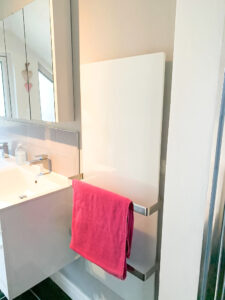No products in the basket.
Time to challenge the conventional measurement of occupier comfort? An independent survey discusses infrared heating.
Summary
In the first independent study of its kind, experimental Psychologist and experienced researcher Dr Alison Kidd has carried out detailed interviews with households heated by Herschel Infrared to find out what motivated them to choose infrared and what they think about their infrared heating system. Alison and the participating households consider thermal comfort of occupiers as well as costs, with an in-depth look into how people are using infrared to keep themselves warm.

Alison’s research analyses different human behaviours around the delivery of comfort within different house types (in terms of style, age and insulation) given the huge diversity of the the UK’s building stock. The findings demonstrate users having a hugely positive experience from infrared and challenge the conventional mindset of using centralised space heating, measuring thermostatically-controlled air temperature, as the primary means of ensuring effective thermal comfort for people. With people varying so greatly in their thermal comfort levels, whether they personally feel hot or cold, the findings question whether it is time to reconsider exactly what is the best way to heat people – comfortably, effectively and without wasting energy?
The Survey
We were delighted to be involved in the survey, invites were sent to Herschel customers who had heated their property for at least 12 months. From the list of applicants, 20 were subsequently selected to ensure a range of property types and sizes were included within the sample. Alison conducted the interviews via Zoom and the recorded interviews were then independently transcribed to enable Alison to conduct her analysis of the language people use to describe their experience.
 Report Findings
Report Findings
The full report can be downloaded via this link. Alison summarises the results from her interviews with 20 households living with infrared and asks whether infrared can keep people comfortably & affordably warm, by heating people directly, in order to minimise energy wastage?
Key highlights from Alison’s analysis include:
- 12 households, out of 20, considered a heat pump but rejected it either because of: installation cost, not wanting either a centralised or wet system with pipes or because their property was perceived as a poor match for this form of heating;
- the households saw the main advantages of IR heating as quick, flexible control of their thermal comfort, if and when they needed it;
- they loved the sensation of sun-like heat directly on their bodies as well as the enveloping warmth;
- running costs didn’t emerge as a major concern for these households relative to the value of quick, highly controllable warmth and their ability to reduce energy use (and cost) when and where it wasn’t needed;
- the households were delighted with and enthusiastic about their choice of heating system.
Occupier Comfort
In terms of occupier comfort and the feeling of heat, the feedback was massively encouraging.
“When I know that the house is chilly and it’s chilly outside and I walk up into my living space and that warmth just envelopes you. It’s really nice.” “It’s flexible, it’s effective, it’s configurable, it’s controllable and it’s a much better option than any kind of convection heating”. “Last year when I was working from home, I could actually just heat the room I was in rather than heating the whole house which was perfect”. “It’s not overbearing. I don’t get that blocked nose. I don’t get the stuffiness from central heating”. “That you don’t have to worry about air escaping if you open a door or a window … whereas normally if you opened a door, you lost heat from the room”.

People all feel comfort differently and perhaps the conventional way we have always measured comfort is outdated. Is it about time we question whether one centrally controlled heating system is the optimum way to achieve occupier comfort, when human physiology differs per individual? The radiant properties of infrared heating mean that people and objects are warmed directly, rather than heating the air as with convection. This allows people more flexibility and control over their own comfort, prioritising their own ‘occupier comfort’ over the heating needs of the building.
Occupier comfort is exactly what should be prioritised when we are looking at heating people in homes. Infrared heating offers a flexible, decentralised heating system where people have the opportunity to prioritise their own comfort, heating themselves over spaces. It also ensures energy usage is minimised in rooms which are unoccupied.
Infrared on the Agenda
The results of the survey and feedback on comfort are incredibly encouraging and we have already shared them as part of our discussions with the UK government to ask them why infrared heating, a proven low carbon technology is not supported in the same way as heat pumps. The UK’s homes and buildings vary widely and not one heating technology fits all. The heating and buildings policy needs urgent review to ensure all low carbon technologies are recognised so that households are motivated to invest in cleaner, greener solutions from a choice of different technologies.
We are delighted to be working with the Sustainable Energy Association who are championing a Technology-Agnostic approach and through their work and recommendations they hope to influence policy in this area moving forward. We will monitor developments within the heat and buildings policy closely and continue to update you as developments take place.
With thanks to Dr Alison Kidd (shown below) and the many participants involved for their time and feedback. Being the first survey of its kind, it has been a hugely interesting and useful exercise to read about why people were seeking a new heating system, why they decided upon infrared and how they find it as a solution in terms of useability, occupier comfort, costs involved. The positive feedback from particating households reinforces the huge benefits that we know exist from our infrared heating systems.

